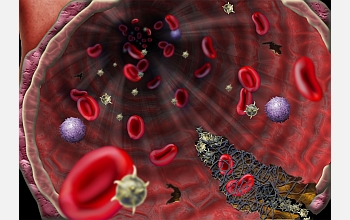News Release 06-149
Novel Laboratory Model Reveals Clues to How Blood Starts Clotting
Approach has potential to reveal mechanisms behind variety of reactions within the body

Scientists have developed a microfluidic system that successfully models blood clotting.
October 17, 2006
This material is available primarily for archival purposes. Telephone numbers or other contact information may be out of date; please see current contact information at media contacts.
Researchers at the University of Chicago have crafted a simple model for predicting when and where hemostasis -- the technical term for blood clotting -- will occur. The microfluidic system that they created focuses on the interactions between blood and surfaces patterned to trigger blood clotting. It allows the researchers to separately monitor clotting in both blood plasma and a chemical model.
The researchers, led by National Science Foundation CAREER awardee Rustem Ismagilov, believe the methodology may prove useful in a range of studies, adding a powerful tool for predicting the dynamics of other complex biochemical networks.
The system successfully modeled the workings of a complex biochemical network by showing how the start of clotting depends upon localization of clotting stimuli. The researchers were even able to use the model to predict behavior that they later confirmed with human blood plasma, finding that blood can be exposed to significant amounts of clotting stimuli, such as tissue factor, without initiating clotting.
Lead author Christian Kastrup and his colleagues present their research results in the Oct. 16, 2006, online Early Edition of the Proceedings of the National Academy of Sciences.
For additional information, see the University of Chicago press release at: http://www-news.uchicago.edu/releases/06/061016.clotting.shtml.
-NSF-
Media Contacts
Joshua A. Chamot, NSF, (703) 292-7730, email: jchamot@nsf.gov
Steve Koppes, University of Chicago, (773) 702-8366, email: s-koppes@uchicago.edu
Program Contacts
Janice M. Hicks, NSF, (703) 292-4956, email: jhicks@nsf.gov
Principal Investigators
Rustem F. Ismagilov, University of Chicago, (773) 702-5816, email: r-ismagilov@uchicago.edu
Related Websites
Ismagilov group homepage: http://ismagilovlab.uchicago.edu/
The U.S. National Science Foundation propels the nation forward by advancing fundamental research in all fields of science and engineering. NSF supports research and people by providing facilities, instruments and funding to support their ingenuity and sustain the U.S. as a global leader in research and innovation. With a fiscal year 2023 budget of $9.5 billion, NSF funds reach all 50 states through grants to nearly 2,000 colleges, universities and institutions. Each year, NSF receives more than 40,000 competitive proposals and makes about 11,000 new awards. Those awards include support for cooperative research with industry, Arctic and Antarctic research and operations, and U.S. participation in international scientific efforts.
Connect with us online
NSF website: nsf.gov
NSF News: nsf.gov/news
For News Media: nsf.gov/news/newsroom
Statistics: nsf.gov/statistics/
Awards database: nsf.gov/awardsearch/
Follow us on social
Twitter: twitter.com/NSF
Facebook: facebook.com/US.NSF
Instagram: instagram.com/nsfgov


